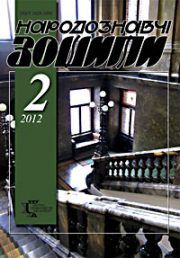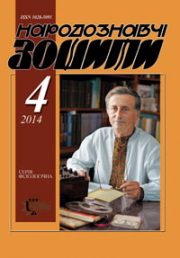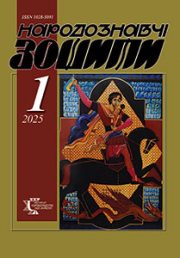The Ethnology Notebooks. 2024. № 1 (175), 30—41
UDK 930.2:[398.332.416/.42:398.47:133.4](=1:477.86/.87+83)”18/20″
DOI https://doi.org/10.15407/nz2024.01.030
«POLAZNYK» IN BOYKO’S REGION: ACTIVE-MAGIC ASPECT (BASED ON FIELD RESEARCH MATERIALS)
SEREBRYAKOVA Olena
- ORCID ID: https://orcid.org/0000-0002-1039-2920
- Candidate of Historical Sciences (= Ph.D. in history).
- Senior researcher of the department of Modern Ethnology
- of the Ethnology Institute
- of the National Academy of Sciences of Ukraine,
- 15, Svobody Avenue, 79000, Lviv, Ukraine,
- Contacts: e-mail: o-sereb@ukr.net
Abstract. The aim of the offered article is coverage of the layer of customary and ritual, worldview phenomena associated and related to the custom of «polaznyk» on the territory of Boyko’s region, introduction into scientific circulation, systematization and analysis of new information.
The object of the research is the traditional worldview and customary, ritual culture of the residents of Boyko’s region, and the subject is the archaic custom of the «polaznyk», which lived among the Boykos. Attention was drawn to the origin of the custom, various ideas and beliefs about the figure of the «polaznyk» («first visitor»), the annual calendar holidays of his visits were revealed. Varieties, local differences, beliefs, customary instructions, ritual taboos, peculiar motivations of the custom are characterized. Also interesting are the data on the personal qualities of the «polaznyk», belief in his magical abilities, functional similarity to the caroler, etc. Examples are given that confirm the close connection of such a ritual guest with the cult of ancestors. This is manifested in the generous gifting of visitors, who were perceived by the people as mediators between the worlds, the personification of the souls of the dead. Actional and verbal levels of the researched custom are revealed. The analysis testifies to various types of original magical rites of protection, production and marriage direction by the first visitor and the owners of the house. It should be noted that beliefs in a man-«polaznyk» is a later phenomenon. This is due to the movement of the folk calendar (from spring to winter), which caused the transformation, a change in the essence of the original custom, the replacement of the symbolic bullock-«polaznyk» by other animals, including unsuitable for agricultural work.
The basis of the article are the materials of the field research, works of the second half of the nineteenth and the beginning of the twenty-first centuries.
The methodology of this work is based on general scientific methodological principles and the basic requirements that apply to the works of historical and ethnological direction. The author uses a various methods (field observation, typological analysis, comparative-historical, comparative, reconstructive, structural-semantic).
Keywords: polaznyk, Boyko’s region, world views, beliefs, guidelines, taboo, magic.
Received 4.01.2024
REFERENCES
- Archive of the Institute of Ethnology of the National Academy of Sciences of Ukraine (then — Archive of the IN NANU). F. 1. Op. 2. Od. save 588. Arc. 1—123 [in Ukrainian].
- Archive of the IN NANU. F. 1. Op. 2. Od. save 590. Arc. 1—49 [in Ukrainian].
- Archive of the IN NANU. F. 1. Op. 2. Od. save 609. Arc. 1—65 [in Ukrainian].
- Archive of the IN NANU. F. 1. Op. 2. Od. save 787. Arc. 1—200 [in Ukrainian].
- Archival scientific collections of manuscripts and audio recordings of M.T. Rylsky Institute of Art Studies, Folklore and Ethnology of the National Academy of Sciences of Ukraine. F. 14—3. Act. 6. Arc. 1—128 [in Ukrainian].
- Archive of the IN NANU. F. 1. Op. 2. Od. save 216. Arc. 1—51 [in Ukrainian].
- Archive of the IN NANU. F. 1. Op. 2. Od. save 217. Arc. 1—32 [in Ukrainian].
- Archive of the IN NANU. F. 1. Op. 2. Od. save 227. Arc. 1—67 [in Ukrainian].
- Archive of the IN NANU. F. 1. Op. 2. Od. save 228. Arc. 1—53 [in Ukrainian].
- Archive of the IN NANU. F. 1. Op. 2. Od. save 240. Arc. 1—65 [in Ukrainian].
- Archive of the IN NANU. F. 1. Op. 2. Od. save 513. Arc. 1—73 [in Ukrainian].
- Archive of the IN NANU. F. 1. Op. 2. Od. save 521. Arc. 1—46 [in Ukrainian].
- Archive of the IN NANU. F. 1. Op. 2. Od. save 533. Arc. 1—183 [in Ukrainian].
- Scientific archive of the Department of Ethnology and Local History, Faculty of History, Taras Shevchenko KNU. F. 3. P. 3. Unit coll. 48. Arc. 1—95 [in Ukrainian].
- Scientific archive of the Department of Ethnology and Local History, Faculty of History, Taras Shevchenko KNU. F. 3. P. 5. Unit coll. 82. Arc. 1—36 [in Ukrainian].
- Franko, I. (1898). Popular beliefs in Pidhirya. Etnohrafichnyj zbirnyk (Vol. V, pp. 160—218). L’viv [in Ukrainian].
- Zubryts’kyj, M. (1900). Folk calendar, folk customs and beliefs tied to days of the week and annual holidays. Materialy do ukrains’koi etnol’ogii (Vol. III, pp. 33—60).Lviv [in Ukrainian].
- Schnaider, J. (1912). From the life of the highlanders above the Lomnytsia river. Lud (Vol. XVIII, pp. 141—217) [in Polish].
- Duchymins’ka, O. (1938). Christmas and St. Jordan customs in the village of Tyapcha (East Boykivshchyna). Litopys Bojkivschyny, 10, 55—59 [in Ukrainian].
- Duchymins’ka, O. (1937). Christmas customs in Tyapcha village. Zhinocha Dolia, 1—2, 3—4 [in Ukrainian].
- Bohatyrev, P.H. (1971). Magical actions, rites and beliefs of Transcarpathia. The questions of the theory of folk art (Pp. 167—296). Moskva: Iskusstvo [in Russian].
- Bohatyrev, P. (2007). «Polaznyk» among southern Slavs, Magyars, Slovaks, Poles and Ukrainians. Experience of comparative study of Slavic rites. Narodnaia kul’tura slavian (Pp. 131—214). Moskva: OHY [in Russian].
- Kutel’makh, K. (2006). Calendar ritual as an ethnogenetic source. In: Ethnogenesis and ethnic history of the population of the Ukrainian Carpathians: in 4 vols. (Vol. II, pp. 473—557). Lviv: Institute of Ethnology of the National Academy of Sciences of Ukraine [in Ukrainian].
- Kutel’makh, K.M. (2001). A journey deep into the ages (Ancient elements in winter rites). Starosambirschyna. Al’manakh (Issue 1, pp. 87—95). L’viv: Misioner [in Ukrainian].
- Zborovs’kyj, P. (2008). The Christmas cycle of holidays according to the tradition of the village of Verkhne Vysotske in the Turkiv region. Ethnology notebooks, 1—2, 49—53 [in Ukrainian].
- Hlushko, M. (2003). The origin of «polaznyk» as a custom of Ukrainian winter calendar rites (a new concept). Narodna tvorchist’ ta etnohrafiia, 3, 83—89 [in Ukrainian].
- Halajchuk, V. (2010). Traditional calendar customs and rites of the Starosambir region. Notes of the Shevchenko Scientific Society (Vol. CCLIX, pp. 138—178). L’viv [in Ukrainian].
- (2020). Unity in diversity. Residents of Boykivshchyna: educational and methodological manual. L’viv; Zhytomyr [in Ukrainian].
- Hromova, N. (2017.). Transformations of the meeting rite of the «polaznyk» in the structure of the winter rites of the residents of Boykivshchyna (end of the 19th — beginning of the 21st century). Narodna tvorchist’ ta etnolohiia, 1, 56—67 [in Ukrainian].
- Hromova, N. (2007). Christmas and New Year rituals of Ukrainians of Boykivshchyna (end 19th century — beginning of 21st century (Сandidat dissertation). Kyiv: National University Name of Taras Shevchenko [in Ukrainian].
- Kolomyjchuk, O. (2022). Calendar rites of Ukrainians of Boykivshchyna: autumn-winter cycle (end of the 19th century — 30-s of the 20th century). Ivano-Frankivs’k: Symfoniia forte [in Ukrainian].
- Komarnyts’kyj, I. (1989).Christmas customs in the village of Lopushanka Khomina, Turchany district. Litopys Bojkivschyny, 1/49, 67—69 [in Ukrainian].
- Prokopyk, V. (1977).Wedding customs in the village of Strelki near Stary Sambor. Litopys Bojkivschyny, 1/25, 30—39 [in Ukrainian].
- Levkyevskaia, E.E., & Tolstoj, N.I. (Ed.). (2004). Beggar. Slavic antiquities: an ethnolinguistic dictionary: in 5 vol. (Vol. 3, pp. 408—411). Moskva: Mezhdunarodnyje otnoshenija [in Russian].
- Valentsova, M.M., Vynohradova, L.N. & Tolstoj, N.I. (Ed.). (1999). Sheepskin outerwear. Slavic antiquities: an ethnolinguistic dictionary: in 5 vol. (Vol. 2, pp. 520—522). Moskva: Mezhdunarodnyje otnoshenija [in Russian].
- Dubyna, R. Christmas and New Year’s Ritual of the Population of Eastern Boykivshchyna (according to materials of expeditionary research). Retrieved from: https://www.pyrohiv.com/activities/rizdvyano-novorichna-obryadovist-naselennya-skhidnoi-boykivshchini-za-materialami-ekspeditsiynikh-do.html







